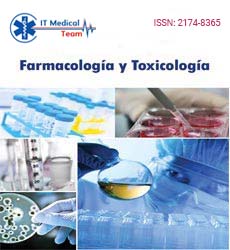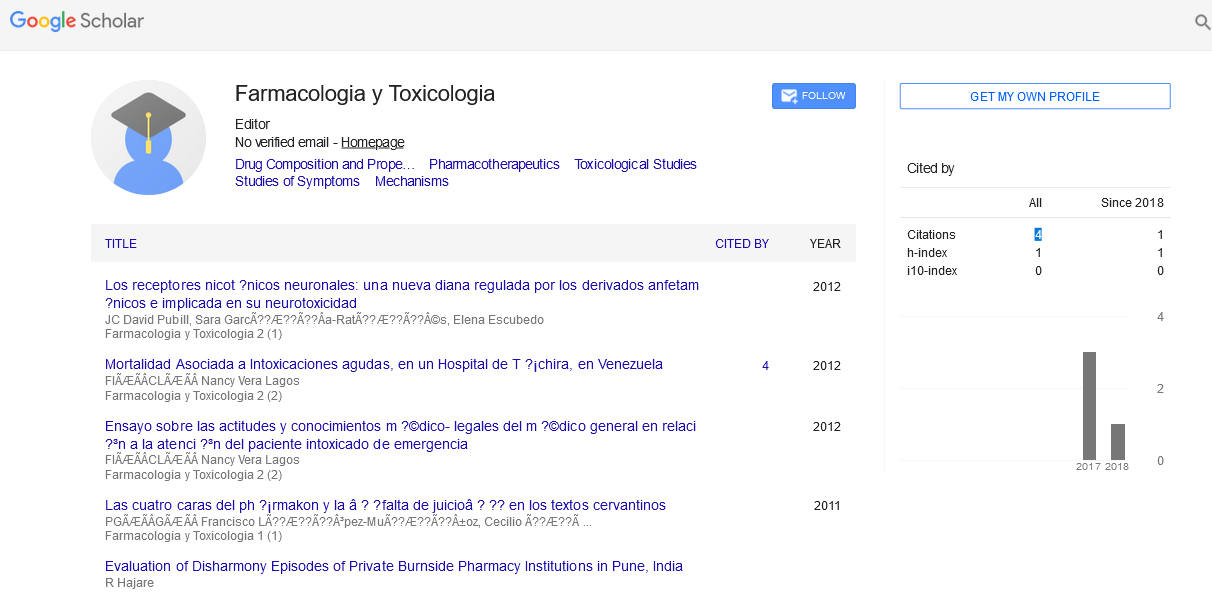Expert Review - (2023) Volume 13, Issue 2
A brief note on the Metal Toxicology and its effect
Lokesh Vadepally Kumar*
Department of Business Management, Poole College of Management, North Carolina State University, Raleigh, NC 27695, USA
*Correspondence:
Lokesh Vadepally Kumar, Department of Business Management, Poole College of Management, North Carolina State University, Raleigh, NC 27695,
USA,
Email:
Received: 03-Apr-2023, Manuscript No. ipft-23-13649;
Editor assigned: 05-Apr-2023, Pre QC No. P-23-13649;
Reviewed: 19-Apr-2023, QC No. Q-23-13649;
Revised: 22-Apr-2023, Manuscript No. R-23-13649;
Published:
28-Apr-2023
Abstract
Metals are naturally occurring elements that can have negative
effects on living organisms. Exposure to toxic metals, such as lead,
mercury, arsenic, cadmium, and aluminium, can lead to various health
problems, including neurological, cardiovascular, respiratory, renal, and
dermatological effects. Metal toxicity can occur through exposure to
metal-containing substances, contaminated water or food, or through
the use of certain products. Preventing exposure to toxic metals is critical
for maintaining good health, and if suspected exposure occurs, seeking
medical attention is important to prevent further damage.
Keywords
Lead; Mercury; Arsenic; Cadmium; Aluminium
Introduction
Metal toxicity is a term used to describe the negative effects
that certain metals can have on living organisms. Metals are
naturally occurring elements that are found in rocks, soil,
water, and air. While some metals, such as iron and zinc,
are essential for human health, others, such as lead and
mercury, can be toxic in even small amounts. Metal toxicity
can occur through exposure to metal-containing substances,
such as industrial pollutants, contaminated water or food,
or through the use of certain products, such as lead-based
paints or mercury-containing thermometers [1]. The
severity of metal toxicity can vary depending on the type of
metal, the dose, and the duration of exposure. Some of the
most common metals that can cause toxicity include lead,
mercury, arsenic, cadmium, and aluminium. These metals
can accumulate in the body over time, leading to various
health problems, including neurological, reproductive, and
developmental disorders. Lead is a particularly concerning
metal when it comes to toxicity. Even low levels of lead
exposure can have a significant impact on children's
cognitive and behavioural development, leading to
learning disabilities and behavioural problems. Adults who
are exposed to lead may experience high blood pressure,
kidney damage, and reproductive problems [2, 3].
Discussion
Mercury is another metal that can be toxic in even small
amounts. Exposure to mercury can cause neurological
damage, leading to tremors, memory loss, and other
cognitive problems. Pregnant women who are exposed
to mercury may also pass the metal onto their developing
fetus, leading to developmental problems. Arsenic is a
metal that is commonly found in groundwater in certain
regions of the world. Exposure to arsenic can cause skin
lesions, respiratory problems, and an increased risk of
cancer. Cadmium exposure can lead to kidney damage,
osteoporosis, and an increased risk of lung cancer [4, 5].
Aluminium toxicity has been linked to neurodegenerative
disorders, such as Alzheimer's disease. Preventing metal
toxicity involves avoiding exposure to metal-containing
substances whenever possible. This can be achieved through
proper waste disposal, using protective gear when working
with metals, and choosing products that do not contain
toxic metals, such as lead-free paints.
1. Here are some ways in which metals can affect the
human body
Neurological effects: Many metals, such as lead, m ercury,
and aluminum, can cause damage to the nervous system.
Symptoms of metal toxicity can include tremors, memory
loss, cognitive problems, and behavioral changes [6].
1.1. Cardiovascular effects: Certain metals, such
as lead, cadmium, and arsenic, can damage the
cardiovascular system, leading to high blood
pressure, heart disease, and stroke.
1.2. Reproductive effects: Exposure to toxic metals
can have adverse effects on reproductive health
in both males and females. For example, lead
exposure can cause infertility in men, while
mercury exposure can affect fetal development in
pregnant women.
1.3. Respiratory effects: Inhalation of metal particles
can lead to respiratory problems, such as asthma
and chronic obstructive pulmonary disease
(COPD).\
1.4. Renal effects: Some metals, such as cadmium
and lead, can accumulate in the kidneys, leading
to kidney damage and chronic kidney disease.
1.5. Gastrointestinal effects: Ingestion of certain
metals, such as lead, can cause gastrointestinal
problems, such as abdominal pain, diarrhea, and
vomiting.
1.6. Dermatological effects: Some metals, such as
nickel and chromium, can cause allergic reactions
and skin irritation.
It's worth noting that the effects of metal toxicity can vary
depending on factors such as age, sex, and pre-existing
health conditions. Children, pregnant women, and the
elderly are particularly vulnerable to the effects of metal
toxicity [7, 8]. Preventing exposure to toxic metals is
critical for maintaining good health and reducing the
risk of negative health outcomes associated with metal
exposure. If you suspect that you have been exposed to a
toxic metal, it is important to seek medical attention right
away to prevent further damage. Metal toxicology is the
study of the effects of metals on living organisms. It involves
understanding how different metals can accumulate in the
body, how they interact with biological systems, and how
they can cause negative health effects. This field of study is
important for understanding the potential risks associated
with exposure to toxic metals and developing strategies to
prevent or mitigate their effects. Metal toxicology is useful
for mankind in several ways. First, it helps to identify
the sources of toxic metals in the environment and assess
the potential risks to human health. For example, metal
toxicologists have identified lead-based paint as a significant
source of lead exposure in children, leading to policies to
remove or mitigate this hazard. Second, metal toxicology
is important for developing regulations and guidelines for
safe exposure levels to metals. This is particularly relevant
for occupational settings where workers may be exposed
to high levels of metals on a regular basis. Guidelines
developed from metal toxicology research can help protect
workers from exposure to harmful levels of metals and
prevent adverse health effects. Third, metal toxicology is
useful for developing strategies to treat metal toxicity when
it occurs. For example, chelation therapy is a medical
treatment that involves the administration of drugs that bind to metals in the body, facilitating their removal. This
treatment has been used to treat lead poisoning and other
metal toxicities [9, 10].
Conclusion
Metals are ubiquitous in our environment and have been
used for thousands of years for various purposes, including
construction, transportation, and manufacturing. While
some metals are essential for human health in small
amounts, others can be toxic even in small doses. Exposure
to toxic metals can lead to a wide range of health problems,
including neurological, cardiovascular, respiratory, renal,
and dermatological effects. Metal toxicology is the study of
the effects of metals on living organisms and is an important
field of study for understanding the risks associated with
exposure to toxic metals. One of the main ways in which
metals can affect the human body is through damage to the
nervous system. Certain metals, such as lead, mercury, and
aluminium, have been linked to neurological problems,
including tremors, memory loss, and cognitive problems.
These metals can accumulate in the body over time, leading
to chronic exposure and long-term damage.
Another important area of concern is the cardiovascular
system. Certain metals, such as lead, cadmium, and arsenic,
have been linked to cardiovascular disease, high blood
pressure, and stroke. Exposure to these metals can lead to
the accumulation of plaque in the arteries, increasing the
risk of cardiovascular problems. Ingestion of toxic metals
can also have adverse effects on reproductive health in both
males and females. For example, lead exposure has been
linked to male infertility, while mercury exposure can affect
fetal development in pregnant women. Exposure to toxic
metals can also cause respiratory problems, such as asthma
and chronic obstructive pulmonary disease (COPD).
Preventing exposure to toxic metals is critical for
maintaining good health and reducing the risk of negative
health outcomes associated with metal exposure. This can
be achieved through various strategies, such as reducing
exposure to metal-containing substances, ensuring safe
drinking water, and using personal protective equipment
in occupational settings. Metal toxicology is useful for
mankind in several ways. It helps to identify the sources
of toxic metals in the environment and assess the potential
risks to human health. This field of study is also important
for developing regulations and guidelines for safe exposure
levels to metals. Guidelines developed from metal toxicology
research can help protect workers from exposure to harmful
levels of metals and prevent adverse health effects. Metal
toxicology is also useful for developing strategies to treat
metal toxicity when it occurs. Metal toxicity is a significant
public health concern that can have serious long-term
effects on human health. Exposure to toxic metals can cause
a wide range of health problems, including neurological,
cardiovascular, respiratory, renal, and dermatological
effects. Metal toxicology is an important field of study for
understanding the risks associated with exposure to toxic
metals and developing strategies to prevent or mitigate their
effects. By identifying sources of exposure and developing
strategies for prevention, we can protect human health and ensure a safe environment for all.
Acknowledgement
None
Conflict of Interest
None
References
- Jaeken J, Hennet T, Matthijs G, et al. CDG nomenclature: time for a change. Biochim Biophys Acta.2009;1792(1): 825-826.
Indexed at, Google Scholar, Crossref
- Faiyaz-Ul-Haque M, Ahmad W, Zaidi SH. Novel mutations in the EXT1 gene in two consanguineous families affected with multiple hereditary exostoses (familial osteochondromatosis). Clinical Genetics.2008; 66(2): 144-151.
Indexed at, Google Scholar, Crossref
- Schmale GA, Conrad EU, Raskind WH. (1994) the natural history of hereditary multiple exostoses. J Bone Jt Surg.1994; 76(2): 986-992.
Indexed at, Google Scholar, Crossref
- Kivioja A, Ervasti H, Kinnunen J, et al. (2000) Chondrosarcoma in a family with multiple hereditary exostoses. The Journal of Bone and Joint Surgery. British Volume.2000; 82(5): 261-266.
Indexed at Google Scholar, Crossref
- Stieber JR, Dormans JP. Manifestations of hereditary multiple exostoses. J Am Acad Orthop Surg. 2005; 13(2): 110-120.
Indexed at, Google Scholar, Crossref
- Zak BM, Crawford BE, Esko JD. Hereditary multiple exostoses and heparan sulfate polymerization. Biochim Biophys Acta-Gen Subj.2002; 1573(4): 346-355.
Indexed at, Google Scholar, Crossref
- Le Merrer M, Legeai-Mallet L, et al. A gene for hereditary multiple exostoses maps to chromosome 19p. Hum Mol Genet. 1994; 3(5): 717–722.
Indexed at, Google Scholar, Crossref
- Alvarez CM, De Vera MA, Heslip TR. Evaluation of the anatomic burden of patients with hereditary multiple exostoses. Clin Orthop Relat Res. 2007; 462(4): 73-79.
Indexed at, Google Scholar, Crossref
- Wu YQ, Heutink P, de Vries BB, et al. Assignment of a second locus for multiple exostoses to the pericentromeric region of chromosome 11. Hum Mol Genet.1994; 3(5): 167-171.
Indexed at, Google Scholar, Crossref
- Irie F, Badie-Mahdavi H, Yamaguchi Y. (2012) Autism-like socio-communicative deficits and stereotypies in mice lacking heparan sulfate. Proc Natl Acad Sci.2012; 109(4): 5052-5056.
Indexed at, Google Scholar, Crossref
Copyright: © Farmacologiay Toxicologia





